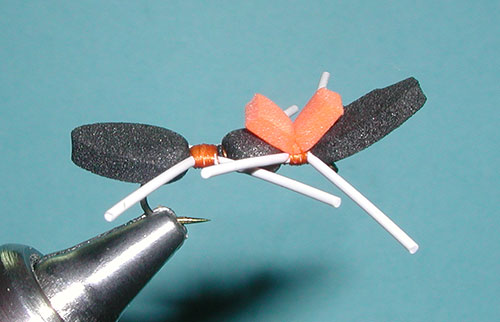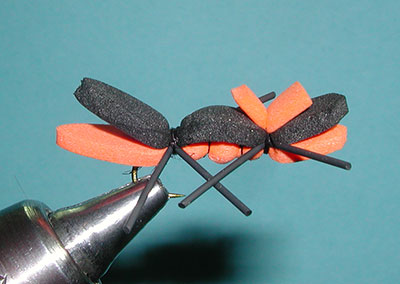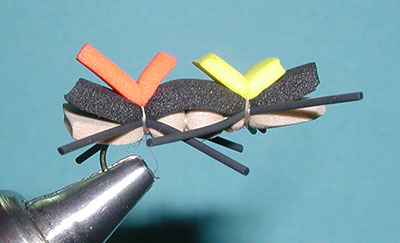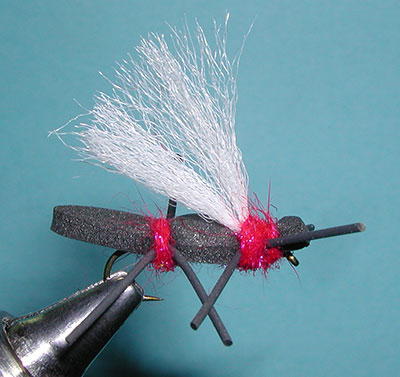Notes: 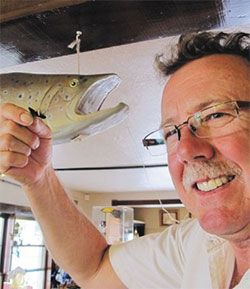 This fly was the winner of the 1995 Jackson Hole One Fly Contest. It was designed by Mark Forslund and Allan Woolley, guides on the Green River below Flaming Gorge, Utah. Originally, Mark tied a piece of black foam that was rounded on both ends and placed two oversized Black hackles in the front and middle portion of the body. Originally, a yellow-dyed calf tail wing was attached to the front segment but this was soon changed to a piece of yellow foam. He named it the Black Mamba. Allan replaced the hackles with two sets of rubber legs for better movement as it was designed as a Mormon Cricket imitation for cutthroats. According to Mark Forslund, a pair of guide pals, Stu Handy, and Mark Bennion, were fishing together and Handy was really tormenting the trout using this pattern. When Bennion asked about the Mamba, Stu explained, “It’s a big black ant.” Bennion examined it and said, “That’s nuclear. It’s an ant directly from Chernobyl,” the nuclear power plant in Ukraine in the Soviet Union that melted down in 1986. Thus the pattern got a new name. The high density foam gives the fly excellent floatation and the rubber legs give it life-like action. The original Chernobyl Ant would often fall on it's side, so initially a parachute hackle was tied below the indicator. Later, this was resolved by using a dubbed body that would serve as ballast when wet and adding a second layer of foam. Many variations are possible with this pattern using various colors of foam. Will Dornan added two major improvements to the pattern with a Poly wing and a large dubbed underbody in the late 1990's. He named his variation, Willy's Red Ant. The Poly wing gave the pattern a much better visability and the dubbed underbody kept the foam from twisting on the hook shank. When the dubbing is wet, it tends to act as ballast for a better presentation when cast. Chenille also works well as an underbody. Some found that if one wing works well, why not try two. So, you find some Chernobyl Ants with both a fore and aft wing. Willy's Red Ant won the 2001 Jackson Hole One Fly Contest, so colors have become ubiquitous with colors of golden stone, purple, salmonfly (rust brown), pink, peach, green, orange, UV tan, olive, and peacock variations available. Best time to use this fly is from Late Summer to Fall from August through November.
It works well as a top dry fly with a dropper nymph. The larger sizes (#6-10) will represent stoneflies and hoppers. This fly was the winner of the 1995 Jackson Hole One Fly Contest. It was designed by Mark Forslund and Allan Woolley, guides on the Green River below Flaming Gorge, Utah. Originally, Mark tied a piece of black foam that was rounded on both ends and placed two oversized Black hackles in the front and middle portion of the body. Originally, a yellow-dyed calf tail wing was attached to the front segment but this was soon changed to a piece of yellow foam. He named it the Black Mamba. Allan replaced the hackles with two sets of rubber legs for better movement as it was designed as a Mormon Cricket imitation for cutthroats. According to Mark Forslund, a pair of guide pals, Stu Handy, and Mark Bennion, were fishing together and Handy was really tormenting the trout using this pattern. When Bennion asked about the Mamba, Stu explained, “It’s a big black ant.” Bennion examined it and said, “That’s nuclear. It’s an ant directly from Chernobyl,” the nuclear power plant in Ukraine in the Soviet Union that melted down in 1986. Thus the pattern got a new name. The high density foam gives the fly excellent floatation and the rubber legs give it life-like action. The original Chernobyl Ant would often fall on it's side, so initially a parachute hackle was tied below the indicator. Later, this was resolved by using a dubbed body that would serve as ballast when wet and adding a second layer of foam. Many variations are possible with this pattern using various colors of foam. Will Dornan added two major improvements to the pattern with a Poly wing and a large dubbed underbody in the late 1990's. He named his variation, Willy's Red Ant. The Poly wing gave the pattern a much better visability and the dubbed underbody kept the foam from twisting on the hook shank. When the dubbing is wet, it tends to act as ballast for a better presentation when cast. Chenille also works well as an underbody. Some found that if one wing works well, why not try two. So, you find some Chernobyl Ants with both a fore and aft wing. Willy's Red Ant won the 2001 Jackson Hole One Fly Contest, so colors have become ubiquitous with colors of golden stone, purple, salmonfly (rust brown), pink, peach, green, orange, UV tan, olive, and peacock variations available. Best time to use this fly is from Late Summer to Fall from August through November.
It works well as a top dry fly with a dropper nymph. The larger sizes (#6-10) will represent stoneflies and hoppers. |


